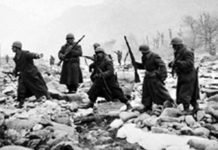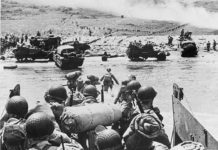World War I was a turning-point in Modern European History. In addition to ushering in a new age, it also should be looked at as a cultural shock. Before the war, the world had known peace, since then, the world has only known war. This is rather simplistic, for sure, but it captures the essense of British thought on the war during the Interwar Period.
A lot of this occurred as a result of the Battle of the Somme. On July 1, 1916, the British after 10 days of shelling of German positions, and after a barrage of a quarter-million shells in only an hour [1], “went over the top.”[2] The shelling failed. As the British soldiers crossed the barbed wire into “No-Man’s Land,” carrying about 30 lbs of equipment [which made it very hard to move], they were “knocked down in rows” [3] by hidden German machine guns. [4] It was the worst day ever for the British army – over 1,000 officers and reserve officers, and 20,000 soldiers were killed, with over 25,000 seriously wounded. [5] It was the worst day ever for any army during the entire war. [6]
A.J.P. Taylor, in his classic history of Interwar Britain, wrote that “Not only men perished. There perished also the zest and idealism with which nearly three million men had marched forth to war.” [7] This zest would never be regained again – even during the Battle of Britain and other battles of World War II, the tone was much more somber than it had been in the halycon days of August 1914. This change became manifested in the serious efforts for peace during the 1920s and 1930s, by Chamberlain and his appeasement policy, and by Churchill’s heavy opposition toward D-Day during World War II.
It was also manifested in British popular culture. One of the effects of this battle was the development of “shell shock” [8] among the soldiers returning from the front. Some, having a harrowing experience, would be scarred forever by it. Many of the more notable would later write books: Robert Grave’s Good-Bye To All That, Siegfried Sassoon’s Memoirs of An Infantry Officer, and Erich Maria Remarque’s classic book All Quiet On the Western Front being some of the better known. Many also would write poetry.
The Battle of the Somme was a clear dividing line between the poetry of the war. Before the war, poetry was upbeat, martial, supportive of Britain’s war effort and cause. After the battle, the tone became more somber and pessimistic, even anti-war.
Even after the war, the effect of the battle carried on. Each November 11th, at 11:00 am during the Interwar Period, a Two-Minute Silence was imposed throughout England. After the war, a war monument was built in London – not one befitting pomp and circumstance – but a simple, somber tower. What a difference a war makes!!
Footnotes:
- [1] Martin Gilbert, World War I: A Complete History, (NY: Henry Holt and Co., 1994), p. 258.
- [2] Ibid.
- [3] A.J.P. Taylor, English History, 1914-1945, (NY: Oxford University Press, 1965), p. 60.
- [4] Gilbert, pp. 258-59.
- [5] Ibid., p. 260.
- [6] Taylor, pp. 60-61.
- [7] Ibid., p. 61.
- [8] Gilbert, p. 275.








